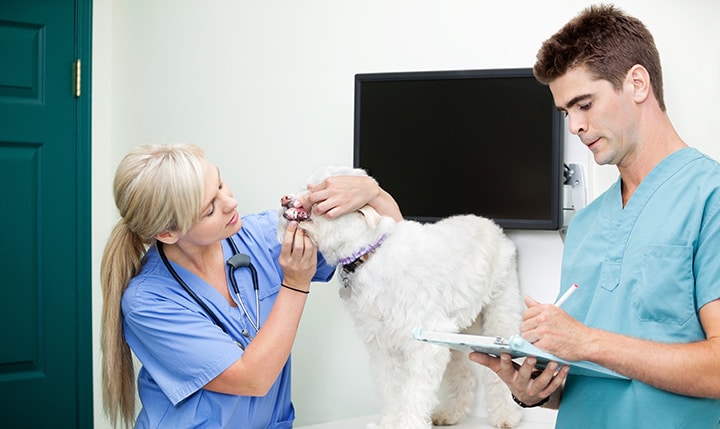Many pet owners are tempted to use human medications from their medicine cabinet to treat their dogs at home. During the springtime allergy season, this becomes an important issue. This is a huge pet safety concern. Without knowing the side effects, or if this medication is even safe to give to your dogs in the first place, pet owners can unknowingly harm their dogs.
It\’s true that veterinarians will administer Benadryl to dogs to treat anxiety, allergies, and motion sickness. However, Splash and Dash Groomerie & Boutique urges you to consult with a pet expert before administering Benadryl for dogs! The FDA has not approved Benadryl for veterinary use even though it is still commonly used by vets in the U.S.
Humans and dogs react very differently to prescription and over-the-counter medication, so please know the pet safety facts first.
This article discusses pet safety and what you need to know about giving your dog Benadryl. Benadryl for dogs can be very helpful, however you need to be aware of the dangers as well as the benefits when giving your dog Benadryl.
What is Benadryl and How Does Work on Humans?
The common name Benadryl is actually a brand name for the active ingredient diphenhydramine which is a \”first-generation ethanolamine-derivative antihistamine.\” In other words, Benadryl is classified as an antihistamine that can cross the blood-brain barrier making the drug very effective.
Diphenhydramine acts as a receptor antagonist to received histamines in the body. Symptoms of springtime allergies like sneezing, itchiness, and hives are relieved once histamines are blocked.
The body is still producing histamines but the receptor antagonist stops the receptor from registering histamines. It\’s kind of like trying to leave a voicemail on a full mailbox.

Pet Safety: How does Benadryl Work on Dogs?
The same clinical functions Benadryl has in humans is also active in dogs. Keeping pet safety and your vets advice in mind, Benadryl for dogs can work to treat seasonal allergies, food allergies, or skin allergies.
Allergy Symptoms Include:
- Itching
- Hives
- Swelling and inflammation
- Redness
- Runny nose and eyes
- Coughing
- Sneezing
- Anaphylactic reaction
A side effect of Benadryl is drowsiness, which can help anxious dogs during a thunderstorm when holistic methods like aromatherapy need clinical administration.
If your pet experiences anxiety during travel, use of Benadryl can also be effective. Keeping extra Benadryl tablets in your pet safety first aid kit might be a good idea for traveling with your pets, once approved by your vet.
Veterinary manuals use the drug to treat symptoms of mild to moderate motion sickness. Veterinarians also use Benadryl during heartworm treatment therapy. Benadryl can counteract symptoms of allergic reactions caused by the treatment.
Be Aware of the Side Effects
The reason pet owners need to exercise pet safety techniques and talk to their vet first before giving dogs medication, is because it might worsen a preexisting condition or work adversely with other medication.
The following conditions do not interact well with Benadryl in dogs:
- Angle-closure glaucoma
- Severe heart failure
- Prostatic hypertrophy
- Bladder neck obstruction
- Seizure disorders
- Hypertension
- Allergic lung disease
- Pregnancy
- Dosage and Avoiding Overdose
Veterinary journals recommend giving dogs 1 mg of Benadryl per pound of body weight two to three times a day. Most drug store diphenhydramine tablets are 25 mg, which is the size used for a 25 pound dog.
Always double check the dosage before giving an over the counter medication. In addition, many formulations are combined with other medications such as Tylenol so make sure Benadryl tablets contain only diphenhydramine.
If you opt to use liquid Benadryl for your dog, use the children\’s\’ formula which does not contain alcohol. Be wary that children\’s liquid formula has different dosage levels than the typical drug.
Never use time capsule release pill tablets! Capsules are absorbed differently in humans than dogs and can also rupture in a dog\’s mouth delivering all the medication instantly. This can lead to an overdose—a pet safety issue that is easily avoided and can lead to a vet hospital visit or even death.
A sign of an overdose is the hyper-excitability of the central nervous system and can be fatal.
 Other symptoms include:
Other symptoms include:
- Rapid heartbeat
- Dilated pupils
- Agitation
- Constipation
- Seizures
If you believe your dog might be experiencing a medication overdose contact your veterinarian and visit an emergency veterinary hospital immediately!
Is Benadryl Relatively Safe for Dogs?
With proper pet safety instructions, the right dosage, and chaperoning from your veterinarian—yes Benadryl can be safe for dogs.
With all medications, please observe your dog\’s behavior while first trial drug usage. Make sure your dog does not react abnormally to the medication before proceeding. Please read all pet safety instructions and monitor expiration dates.
Using an antihistamine medication might be an answer to your dog\’s allergies in the spring, but make sure you\’re doing this properly for your pet\’s safety and health.
When Should I Contact a Vet?
Oral Benadryl is considered a mild to moderately effective antihistamine. If your pet is having an acute allergic reaction with facial swelling or difficulty breathing, skip the oral medications and go straight to the vet.
Many allergic diseases require a combination of medications and treatment of underlying infections; if your pet is not responding well to the medication, talk to your vet for other options.
Follow Splash and Dash Groomerie & Boutique:
- Website: http://splashanddashfordogs.com/
- Franchise Website: https://splashanddashfranchise.com/
- Facebook: https://www.facebook.com/splashanddashfordogs/
- Instagram: @splashanddashfordogs



